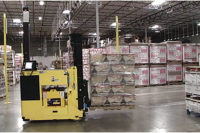Like a forklift, AGVs transport cargo, typically pallets of product in beverage applications, from the end of the production line to be stored or shipped. But AGVs do the job without an operator, depending on software to assign orders and using lasers and sensors to find the product and avoid obstacles.
“It’s linking the palletizer and stretch wrapper with the warehousing activities,” says Mark Longacre, marketing manager for the automated systems group at JBT Corp., Chicago. “Automatic guided vehicles are a great type of technology to automate that end of the plant.”
Most AGVs are battery powered, but the technology used to guide the vehicles is quickly evolving, says John Hayes, sales manager at HK Systems Inc., Park City, Utah. Initially, wires guided vehicles to the cargo, but that method gave way to magnetic, inertial guidance. Today, laser guidance is the standard but, it is in jeopardy of being overtaken by vision and global positioning systems, he says.
Two distinct groups of AGV adopters exist: those implementing automation from end-to-end and others who keep it simple, Hayes says. Although end-to-end users maximize the benefits of AGVs, companies using the vehicles to tackle simpler, low-risk tasks still show savings, he says.
Although most AGV uses are repetitive movements, they can be used as part of a hub and spoke network with multiple pickup points and multiple drop off points, JBT’s Longacre says.
To make a business case for installing an AGV, the machine must be easy to use and perform every task a forklift can, says Mark Stevenson, vice president of business development for Egemin Automation Inc., Holland, Mich.
Egemin now uses standardized off-the-shelf components where possible to help reduce the total ownership cost of its line of AGVs and make the machines easier to use, he says.
“You no longer have to be a rocket scientist to install and maintain an AGV system,” Stevenson says.
But the primary savings in an AGV come from eliminating labor costs in transporting cargo from one place to another, he says. By using an AGV, a beverage company can better use forklift operators for the most value-added lift truck activities or eliminate the position altogether.
“At the end of the day, the most important consideration is transportation from A to B,” he says. “That’s still where the savings is.”
Value added
While the most direct benefit of using an AGV comes from eliminating labor costs, beverage companies also can create consistency in the process of moving cargo from the production line to the warehouse or shipping areas, reduce product damage, and provide the company with flexibility to grow, shrink and move production without employee problems, says Bruce Buscher, vice president of sales for Jervis B. Webb Co., Farmington Hills, Mich.
“AGVs offer more flexibility … by allowing customers to quickly and easily modify their systems, which is necessary in today’s marketplace,” Buscher says.
AGVs eliminate the potential for driver error, which can damage a product or parts of the plant, JBT’s Longacre says.
“There’s a certain amount of damage that’s done due to handling or mishandling, whether it’s careless driving or aggressive driving in forklifts,” he says. “… People are just underutilized doing those things. That’s when they get careless and make mistakes.”
For example, a forklift operator might run over a box or other obstacle in a plant, but an AGV’s guidance system will detect obstacles and slow down as it approaches. If the obstacle is not removed, the AGV will come to a complete stop, Longacre says.
Another advantage to AGVs is lifespan, Egemin’s Stevenson says. A typical AGV has a life of 10 to 15 years, he says, compared to about 5 to 7 years for a lift truck. “And they run 24 hours, 7 days a week, without health benefits,” he says.
Available options
Egemin offers a full line of AGVs, including forked, tugger, unitload, trailer loading and customized units. For the beverage industry, Stevenson says counterbalanced forked vehicles are the most common AGV.
Egemin has created its E’gv line of AGVs, which feature a graphical touch screen, laser-based bumper safety system, electric steering and AC drive assemblies. The vehicles can be dispatched manually and automatically and have an onboard computer running the Windows operating system.
Egemin’s line of counterbalanced AGVs can be fitted with single or dual forks, slip sheet/push-pull mechanisms, clamps, side forks, fork over straddles, as standard attachments found on lift trucks. The line has lift capacities up to 30 feet and 5,500 pounds.
JBT Corp. also offers forked vehicles, Longacre says. “It’s just so flexible. It can interface with racking [or] the floor. It can pick off of conveyors. It can just do so many different things,” he says.
JBT can provide single fork, double fork, single/double attachments, clamps and custom lifting rig AGVs. The company’s AGVs can stack product on the floor and interface with stands, conveyors, standard racking, flow racking and pushback racking, the company says. A host computer tracks movement of all vehicles and products as well.
For beverage companies that require something outside of the traditional AGV mold, HK Systems can custom build AGVs, in addition to the company’s standard line of counterbalanced fork lift and unit load AGVs. The fork lift line of AGVs from HK Systems can carry 2,000 to 7,500 pounds, Hayes says.
HK Systems also offers a very narrow aisle AGV, the HK75T. The HK75T is built for narrow racking aisles and can lift up to 35 feet, he says. Hayes says HK Systems is working on a freezer AGV as well.
The company’s standard line requires little or no customization from project to project and can be implemented much faster, Hayes says.
“It stands to reason the faster the project moves from concept to operating in a facility, the faster the return is realized,” he says.
For case picking applications, Dematic Corp., Grand Rapids, Mich., introduced its LaserTrucks+ line of AGVs, which combines laser guided pallet trucks with a voice directed system.
To start an order, the AGV delivers a new pallet to the picker and then automatically moves with the voice-equipped picker, Dematic says. Once the order is completed, the LaserTruck transports the completed pallet to shipping. BI
AGVs spur operation elimination
Having reached the low-hanging fruit of efficiencies in the production process, beverage companies can turn to the end of their production lines to cut costs by reducing labor costs through installation of automatic guided vehicles (AGV), manufacturers of the machines say.

